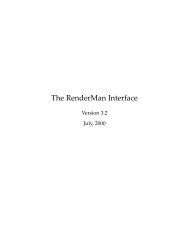Rag doll physics simulation - NCCA People A-Z
Rag doll physics simulation - NCCA People A-Z
Rag doll physics simulation - NCCA People A-Z
You also want an ePaper? Increase the reach of your titles
YUMPU automatically turns print PDFs into web optimized ePapers that Google loves.
For example, when a single body is colliding with the ground we always know that the body willbe falling into the ground and considering that the collision normal must always be given fromthe first body’s point of view, which means that the direction will be in the up vector or y axis(see Figure 6) assuming that the ground is not in a slope as follows:̂ [ ]Considering the values available for this case we can deduce that the calculation for theseparating velocity is as seen in Equation 18 (Millington, 2007).⃗⃗⃗⃗⃗⃗ ( ⃗⃗⃗⃗⃗ ⃗⃗⃗⃗⃗) ̂EQUATION 18: SEPARATING VELOCITY AFTER COLLISION WITH IMMOVABLE BODY⃗⃗⃗⃗⃗⃗⃗⃗⃗⃗̂FIGURE 6: SEPARATING VELOCITY AFTER COLLIDING WITH FLOOR4.4.4. ImpulsesWhen talking about Newton’s third law of motion impulse was defined as a force that is onlyapplied once because of it being caused by a sudden change in direction between bodies.Well, that is exactly what an impulse is, an instantaneous change in velocity caused by collidingwith another body or an opposing force. In the same way that we deduced the calculation forforce in Equation 1 we can do the same for impulse in Equation 19 (Millington, 2007).⃗⃗EQUATION 19: IMPULSE AT COLLISIONWhere ⃗ is the resulting impulse, is the mass of the body to which the impulse is applied and ⃗ isthe velocity the mass is travelling after collision.By using D’ Alembert’s principle, we can calculate the new velocity a body has to take in orderto comply with the impulses applied to a body during collisions. Like for example a box cancollide with another box after falling on top of it and hit more than one point on the box. Eachone of the contacts the boxes have during the moment of collision will generate a separateimpulse to force the separation between them. In order to do this we need to look at Equation20 (Millington, 2007).⃗⃗⃗⃗ ⃗ ⃗EQUATION 20: CHANGE IN VELOCITY PER INDIVIDUAL IMPULSE GENERATED20















